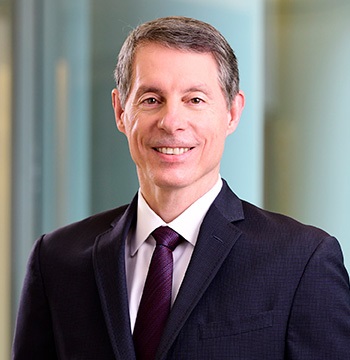Bonds & Loans: A range of social and economic forces seem to be weighing unevenly on emerging markets, whether it’s rising populism, slowing regional growth in the Americas and Asia, or the weaponization of trade policy. How do you see emerging markets performing through the remainder of 2019 and 2020 against that backdrop? What do you see as some of the major risks or potential tailwinds on the horizon?
John Gandolfo: Emerging-market activity continues to moderate as a result of slowing global growth. However, a consequence of slowing global growth is accommodative monetary policies by developed-economy central banks and reflationary efforts by China, which on balance may be positive for emerging markets.
Trade uncertainty has begun to weigh on global manufacturing, and ongoing trade tensions between major economies remain a downside risk. Monetary and fiscal policy will play an important role in bolstering global growth. Domestic demand in major emerging-market economies continues to be sluggish, with negative implications for risk assets in emerging markets. In the short term, we are likely to see continued market volatility until there’s convincing evidence the global economy is turning the corner.
Bonds & Loans: We’ve seen a rise in attention being paid to ESG among financial decision-makers, and investors in particular. But what do you think needs to happen in order for ESG-linked borrowing structures to become more prevalent – particularly in emerging markets?
 John Gandolfo: We integrate ESG into all our investment decisions. Other investors are increasingly doing the same. This has led to stronger corporate governance and deeper awareness of ESG-related factors in companies, with an increasing number of companies incorporating sustainability standards into their business operations.
John Gandolfo: We integrate ESG into all our investment decisions. Other investors are increasingly doing the same. This has led to stronger corporate governance and deeper awareness of ESG-related factors in companies, with an increasing number of companies incorporating sustainability standards into their business operations.
In addition, the market for impact investing has grown exponentially in recent years. We see growth of impact investing continuing to be robust. Trillions of dollars in financing are needed to achieve the UN Sustainable Development Goals. At IFC, we see a strong pipeline of projects coming out of emerging markets that will represent attractive opportunities for investors.
A growing number of fixed-income investors are turning to thematic bonds, including in emerging markets. IFC is working on green-bond initiatives that are helping to catalyze investment in environmentally friendly projects in EMs, including the Emerging Green One fund with Amundi and the Real Economy Green Investment Opportunity fund with HSBC.
Several factors would boost ESG-linked borrowing in emerging markets, such as helping issuers debut in the market; encouraging issuances from beyond the market-linked investments universe, such as in the corporate and sovereign sectors; enabling established issuers to issue in EM currencies; and depending on an investor’s risk appetite, allowing investors to gain direct exposure to green-bond projects.
In the EM space, governance can be a perceived risk to investors, and this is where frameworks such as the Green, Social and Sustainability Bond Principles; the Green Loan Principles; and the Sustainability Linked Loan Principles have been incredibly important in providing guidance for ESG issuers, borrowers and investors. Standards like these give the market confidence in the integrity of ESG securities, and issuers and borrowers that align with these principles gain credibility.
IFC is an active participant in developing the market, above and beyond our issuance activities. We are on the Executive Committee of the Green Bond Principles, and we chair the Social Bond Working Group. We contributed to the development of the Green Loan Principles. Transparency on the use of proceeds and reporting is fundamental to boosting the growth of the market. As such, IFC publishes its Green Bond Impact Report and Social Bond Impact Report for investors on an annual basis.
As more investors unite around new platforms to facilitate investor participation, IFC is exploring tools to bring in new types of investors. In July, IFC launched its Social Impact Notes, which allow retail investors to participate for the first time in IFC-issued bonds. IFC will provide annual impact reporting to investors on projects financed using the proceeds of the bonds.
IFC has been a global leader in ESG since we launched our Environmental & Social Performance Standards 20 years ago. Our experience has demonstrated that ESG isn’t just good for society and the planet—it’s good business.
In April, IFC launched its Operating Principles for Impact Management to provide a common discipline and market consensus for the management of investments to ensure that investments labeled “impact” deliver the social and environmental benefits they claim to. Sixty-three institutions have signed up to the principles, including BNP Paribas Asset Management, Credit Suisse, and UBS Group.
Bonds & Loans: CFOs and Treasurers are hearing more about ‘blended finance’ and related structured financing techniques that help more effectively match risk appetites of liquidity providers with borrowers in need of financing. But could the viability of some of these techniques come under threat when interest rates begin to rise from nearly a decade of historical lows? If so, how can borrowers and liquidity providers mitigate against that risk?
John Gandolfo: Blended finance is generally understood within the development community as the “blending” of financial resources provided by non-profit donors with more traditional commercial sources of private finance to bring to fruition projects with major developmental impact. By de-risking investments, blended financing enables projects to proceed that wouldn’t be completed on a purely commercial basis. This can happen in several ways, including insurance or guarantees that mitigate credit and or market risks.
There are many different ways to structure a project, but at IFC we strive to do so in a way that allows clients and projects to withstand various stress scenarios. One of the stressors could be currency risk that a project will need to take if the financing is in USD, but revenues are in local currencies. In nascent markets, traditional currency hedging solutions such as currency swaps are generally not available. To address such market failure, IFC could provide a local currency loan to the client and hedge the currency risk through a donor facility, while keeping the credit risk of the project on its own balance sheet.
Bonds & Loans: Fintech appears to be quite promising in certain contexts. What role do you see fintech playing in mobilising capital for emerging market borrowers? Where do you see fintech potentially being extremely disruptive for incumbents?
Debt markets are undergoing a rapid transformation. Digital technologies--including process automation, advanced analytics, blockchain and smart contracts—will improve information flow and allow the automation of deal processing. With the right regulatory environment and transparency, new technologies could also help regulators and improve secondary market trading. Thanks to the spread of technology, we expect transaction costs to fall over time, making primary markets accessible to a wider set of issuers.
“Regtech” is helping regulators improve monitoring of transactions, and adoption by EM banks can mitigate the negative effects of de-risking on financial inclusion and provide a potential cost-effective solution for fulfilling their anti-money laundering obligations and ensuring they are able to continue serving their clients.
Bonds & Loans: Infrastructure development is a huge potential driver of growth in emerging markets – but it can suffer from chronic under-investment in some regions. How is IFC working with banks, asset managers and insurers to funnel more private sector capital into emerging market infrastructure projects?
John Gandolfo: The annual investment needed for global infrastructure is estimated to be on the order of USD3.7tn per year, and the gap is particularly significant in emerging markets. Through its syndications business, IFC has attracted banks and asset managers to provide more than USD16bn in loans to EM infrastructure over the last 5 years.
IFC’s Managed Co-Lending Portfolio Program (MCPP) is giving institutional investors a way to allocate some of their capital to EM loans. MCPP uses a portfolio approach: investors receive priority access to IFC’s proprietary pipeline, and benefit from IFC’s unique diversification across countries and sectors. IFC is the lender of record, reducing transaction costs for borrowers and providing valuable long-tenor debt financing from third parties on the same terms as IFC’s own lending.
Over time, IFC builds diversified portfolios for investors that mimic IFC’s own portfolio. To date, of the USD8bn raised by MCPP, IFC has raised USD2bn exclusively for EM infrastructure.









